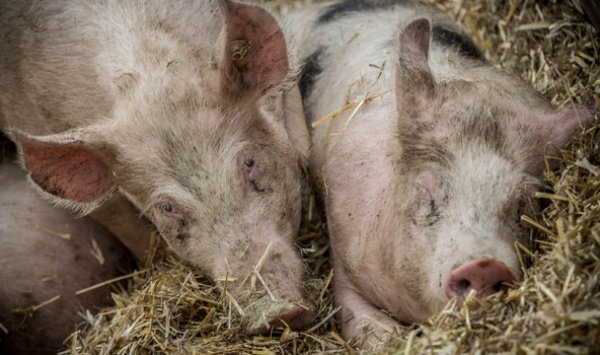African swine fever (ASF) is recognized as a serious and dangerous infectious disease. The mortality rate among wild and domestic animals is very high. The virus affects all livestock, despite the age and quality of piglets.. One good news is that ASF is not transmitted to humans, but agriculture is causing a big loss because they have not yet developed a serum to treat this disease. In this article you will learn about the symptoms of this disease and how to prevent it.
Table of contents
African swine fever
African swine fever - animal infectious pathology. Source of disease - DNA that contains a virus. It belongs to a separate category. There are A and B species of this virus, as well as a subspecies of C. It is resistant to temperature changes, it is not susceptible to freezing, rotting and drying.
ASF came to us from South Africa. The first signs of the appearance of pathology were recorded in 1903. After that, the virus appeared in Portugal and Spain, and from there in Central and South America. Today, the likelihood of being infected with plague is in any part of the world.
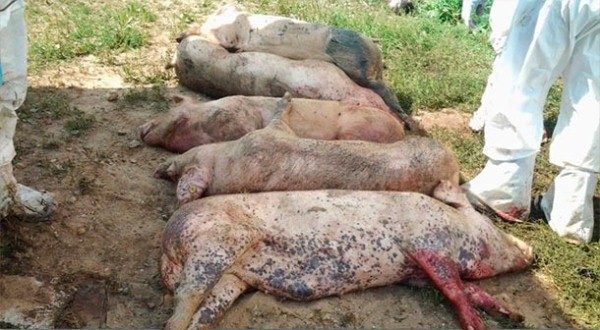
Carriers of infection are infected or recovered pigs.that carry the pathogen up to 18 months.
Infection enters the body through damaged mucous membrane, skin, blood, insect bites, with contaminated food and alimentary. With the appearance of the first signs, about 37% of the livestock become victims of the disease. This disease is dangerous, regardless of where the animal is kept.
The first symptoms and signs
Incubation period Lasts 1-2 weeks. Therefore, to diagnose immediately and correctly is not always possible. Depending on the extent of the disease, different signs appear:
- high temperature (above 40 ° C);
- lack of appetite;
- manifestation of apathy;
- difficult breath;
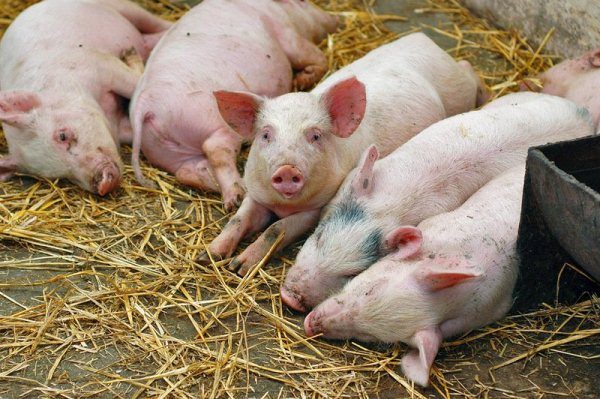
- allotment from the nose and eyes;
- in some cases - moult;
- harsh case;
- dysmotility;
- failure of the gastrointestinal tract;
- bruising, subcutaneous edema;
- variable fever;
- pneumonia;
Due to the variability of symptoms (virus mutation), they may not appear in all animals.
Chronic and atypical form of the disease
Depending on the degree of infection, distinguish between chronic and atypical form of the disease.
Chronic plague may last up to two months or more. Pigs suffer from periodic diarrhea, bouts of fever, anorexia, pneumonia. Animals lose weight, skin frowns, bruises appear on the ears, tail and limbs. With this form of the disease, the clinical signs can vary greatly. All infections end with a lethal outbreak of mischief.. The virus is not excreted from the body, and such pigs remain carriers of the virus.
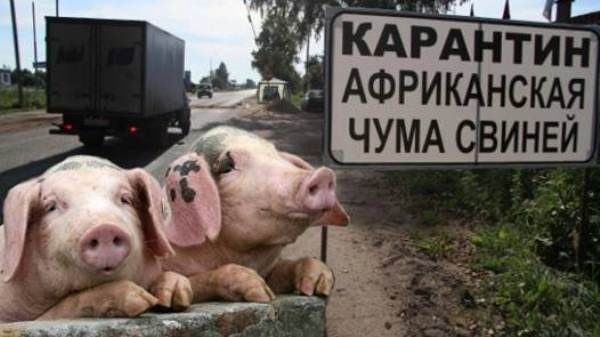
Atypical form of the American virus are often diagnosed in suckling piglets and weaners, who have maternal immunity, or they are infected with the weakly virulent serogroup B virus. In the early stages of the disease, the plague is clinically manifested by refusal of food, conjunctivitis, and bruising. Some piglets recover completely, while others have complications with secondary bacterial viruses. Because of this, there is a massive pneumonia and gastroenterocolitis, which ends with the death of the animal within three days. Infected pigs do not recover until the end and remain carriers of the disease for a long time. Mortality in such cases is 30 - 60%.
Diagnosis of ASF
Without laboratory tests, it is impossible to establish an accurate diagnosis of African plague. Diagnosis is carried out on the basis of pathological and epizootological data., clinical symptoms and laboratory test results. To do this, a blood sample is taken from sick animals, and fragments of organs are taken from corpses.
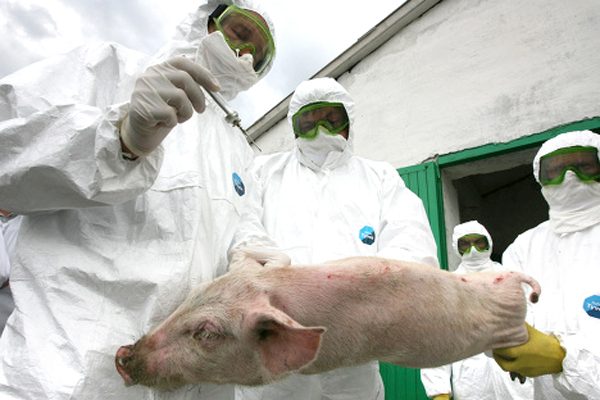
The delivery of particles of the spleen from a larger number of animals is carried out in the event that it is possible to isolate the virus and establish pathology. The biomaterial is transmitted in a qualitative form, and delivered in a short time. Therefore, each particle is placed in an individual bag, and then in a container with ice. Fragments must not be frozen.I, rather simple cooling.
Blood sample for serum immunoassay (ELISA) should be taken from animals that have been ill for a long time or have been in contact with infected piglets and are suspected of being infected with the plague virus.
Virus treatment, quarantine
Today they have not yet developed drugs to combat this disease, and African swine fever is considered deadly. In the first period of infection, which caused suspected ASF, some pig farms produce emergency vaccination of all animals.Such measures save part of the infected pigs. According to animal husbandry technology, all livestock slaughtered in an isolated area with subsequent burning of corpses. In some household farms, an effective means of dealing with ASF in the initial stages is practiced. The animal is poured into the mouth 100 - 150 g of vodka. In most cases, the pig is recovering.

Classical methods of disease prevention
For, to prevent infection pig farms, both in the classical distemper and in ASF, should follow these rules:
- feed in places where there are no viral infections. Heat treatment before feeding;
- systematically disinfect farms and feed stores, as well as treatment against various parasites;
- prevent pigs from contacting animals from other farms, domestic animals and carnivorous birds, which are carriers of infection;
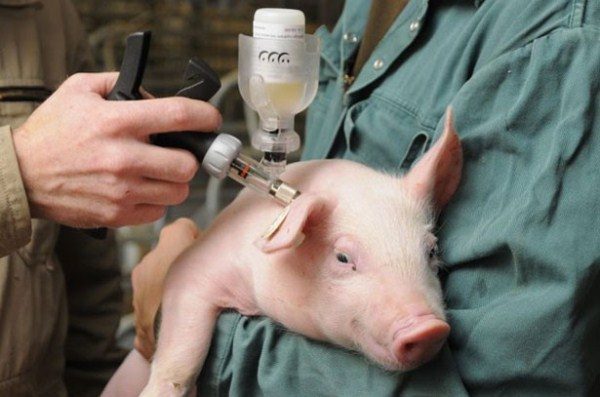
- do not deliver on the pig farm not disinfected inventoryas well as transport from contaminated areas that have not been processed;
- purchase pigs with veterinary documents onlywhich confirms the data on the health of the animal. Imported piglets should be isolated before entering the common pen;
- regularly vaccinate against major diseasesDo not forget to carry out veterinary inspections. Slaughter animals in specialized places.
Is African swine fever dangerous for humans and is it possible to eat such meat?
If you ask the question: "Is it necessary to fear this disease to a person?", Then the exact answer is very difficult to obtain. For humans, this disease is not particularly dangerous.. More precisely, no cases of human infection were recorded. Production of diseased animals can be used in the preparation, only after a long heat treatment (you can cook and fry the meat, but smoking does not kill viruses). But if you think about it, the risk of infection still exists. This disease, and it has not been studied until the end. Some examples of this are:
- The ASF virus is not harmful to humans., but any infection weakens the protective reaction of any organism.There have been cases of detecting antibodies against plague in the human body, which means the likelihood that people can tolerate this pathology without symptoms.
- This infection develops unexpectedly, being a single representative in the class of asfaviruses. The virus mutates, which can lead to an increase in its species. There is a risk that a person can become infected.
- There is evidence of virus detection in people suffering tropical fever. This infection can accompany the development of various serious diseases.

It can be concluded that African swine fever is not a huge danger to humans, but for safety it is necessary to avoid contact with infected pigs.
African swine fever is fatal. Caused by a special survivability of the virus, which, when ingested by a pig, begins to multiply rapidly. Immediately affects animals within a radius of up to 10 km. Therefore, in most countries, at the government level, action to prevent and combat infection in African swine fever, as well as an educational program on what can be and how to recognize signs of African swine fever in pigs.
